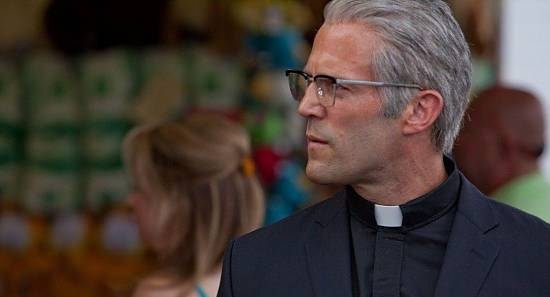 |
| The scary thing isn't the special effects in this movie... it's the emotional reality of the performances. |
"The undead surround me. Have you ever talked to a corpse? It's boring! I'm lonely! Kill yourself, David, before you kill others."
1) While I know most people think of this as a comedy, it's actually not; it's a full on horror with some strong comedic elements solely for the purpose of relieving the tension. In almost every way, Landis structures the film like a classic Universal Monster Movie (even namechecking The Wolf Man in a key scene to foreshadow the climax), only with a decidedly 70's sensibility.
2) Landis spends almost twenty minutes with David Naughton's David and Griffin Dunne's Jack before Jack gets et, and David gets lycanthropized. And almost all of that twenty minutes is a conversation between the two. This serves a number of purposes--it cements our identification with David, it makes the friendship between the two real so that it makes sense that Jack would try to counsel David from beyond the grave, and established Jack's light-heartedness, which makes his humorous, gruesome appearances later in the film logical.
 |
| In the future, Body Mods will get really, really weird.... |
4) ...but then, so much of this movie is about the characters. There's a reason Landis takes almost an hour to get to David transformation into his wolf form; it's so we can get to know David, Jenny Agutter's Alex, even John Woodvine's surgeon. And it's because we're comfortable with these characters that the horror of what happens is amplified in that last forty minutes.
5) I appreciate how we never get a full back story for East Proctor. Landis realizes that we don't need to know anything other than there's a werewolf, and everyone knows about it. And it encourages us to make that back story up....
6) Given that my last exposure to John Woodvine was in his scenery-ingesting performance in the Doctor Who serial 'The Armageddon Factor', I was incredibly struck by his turn as Doctor Hirsch, who ends up playing the Van Helsing role. Woodvine is incredibly subtle and sympathetic, and watching him slowly put together the pieces of this puzzle and then using that information to try to aid David and Alex. It's a marvelous little performance.
 |
| Quite frankly, Jenny Agutter could turn any man into a wolf... |
8) I'll say it...the ultimate form of the werewolf is a bit crap, looking decidedly...fluffy with its heavy coat. But Landis is smart, showing us the monster in very quick cuts or in deep darkness--and those that are relatively clear he shows obscured by the panicked crowd. It allows the monster to still seem frightening and formidable within the constraints of the budget.
9) That being said, the real highlight of Rick Baker's work is the transformation scene, which is effective due to extremely clever editing to give us the illusion we're watching a single, fluid scene where Naughton distorts into a wolf. It's a magnificently scary and wonderful scene, made all the more strange by the choice of music.
10) You know, the scene that made me cringe the most isn't one with any of the special effects in it--it was the scene where David is in the phone booth saying goodbye to his family through his little sister moments before he's ready to slit his wrists. Even though Naughton is a limited actor, he rises to the occasion, making his despair and horror absolutely real. He also achieves a similar level of magnificence during the scene where he's trying to repel Alex and begs a policeman to lock him up before he kills again.
Overall...a film that, because we tend to focus on the humor, is miscategorized. This isn't a comedy with horror elements, but a horror film that's emotionally real with comedic elements. Absolutely essential viewing for horror fans.











